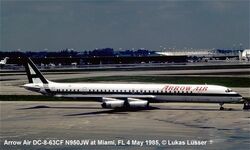
Arrow Air Flight 1285
Real Names: Various
Case: Conspiracy/Suspicious Deaths
Date: December 12, 1985
Location: Gander, Newfoundland
Case[]
Details: On December 12, 1985, two hundred and fifty-six people died when a charter Arrow Air DC-8 crashed almost immediately after takeoff from Gander International Airfield in Newfoundland. All of the passengers were members of the 101st Airborne Division assigned to a peace-keeping force in the Sinai Peninsula. The previous day, the plane had left Cairo Airport and was headed to Fort Campbell, Kentucky, with a fateful stopover at Gander. The crash was the worst single air disaster in U.S. military history.
The crash occurred just three miles from the control tower. The wreckage was spread across an area 1,300 feet long and 130 feet wide. Almost immediately, a man claiming to represent the terrorist organization Islamic Jihad telephoned a U.S. consulate in Algeria. He said that the group was responsible for the crash. The Canadian air crash investigators from the Canadian Aviation Safety Board (CASB) took this claim seriously and walked from the end of the runway to the crash site where they found no pieces of the plane had come off before the crash and discounted any possible terrorist involvement.
Five out of the nine CASB board members determined that ice on the wings and the plane being 12,000 pounds above its calculated weight had caused the crash. However, four board members dissented, claiming that there was evidence that terrorism had indeed caused the crash. Les Filotas, one of the dissenting board members, believed that there was evidence of an explosion on the plane.
The U.S. Government denied that any explosives or ammunition were being carried as cargo on the plane.
Eyewitness reports at Cairo seem to contradict the government's statement. The 101st Airborne Division members waited for eight hours before they were transported to a larger plane. The duffel bags of forty-one soldiers were left behind on the tarmac so room could be made for several large wooden boxes. Some believe that the boxes contained highly classified weapons. At the crash site, rescue worker Harvey Day claimed to have seen five wooden boxes. Military officials prevented him from looking closer at them. He claimed that he saw weapons, missiles, and ammunition boxes.
Harvey also remembered that there was one unusual hot spot at the crash site that could not be easily put out by water. Within days, several rescue workers began to complain of health problems. The symptoms were apparently similar to that of radiation poisoning.
According to one unnamed source, the U.S. Government sealed their records on the crash for seventy years. However, several government agencies, including the Department of Defense and the National Transportation Safety Board, deny that such records exist. Family members of the passengers believe that there is something in the records that the government is purposefully hiding.
In the early 1980s, the U.S. government began illegally selling arms to Iran in a covert operation known as Iran-Contra. The operation was done in an attempt to free hostages in the Middle East. Allegedly, at around the time of the crash, the operation was in jeopardy. Just a few days before the crash, Col. Oliver North warned that the U.S. risked a new wave of terrorism.
The U.S. government officials did appear to be acting strangely after the crash. For unknown reasons, the crash site was bulldozed within three months, a highly unusual practice. The Army claimed that it was done simply to discourage souvenir hunters. Shortly after, the remains of the plane were quickly disposed of by being buried in a dump. This was also a highly unusual procedure. Normally, downed planes are reassembled in order to study the crash.
The parents of soldier James Douglas Phillips formed a group called "Families for Truth about Gander" in hopes of finding out what really caused the crash. They requested several scrap sections from the DC-8. An expert looked at the scrap pieces and felt that the outward, puckered edges indicated that a blast had occurred inside the plane. Phillips' father believes that an explosion occurred in the air, which caused the plane to break apart and crash.
The dissenting board members argued that autopsies showed that many of the soldiers had significant amounts of carbon monoxide in their bodies, suggesting that a fire or explosion was on the plane before it crashed. However, the high traces of carbon monoxide in their lungs was likely due to the intense post-crash fire.
In 1990, a congressional hearing on the crash was convened in Washington, D.C. While the committee did criticize the government's lackluster post-crash investigation, it did not recommend a full-scale reinvestigation. The families of the victims are still searching for answers in the crash.
Suspects: A purported representative of the terrorist organization Islamic Jihad claimed responsibility for the crash. However, military investigators and the five CASB board members argue that there is no evidence to support the organization being involved.
Some believe that an accidental explosion occurred on-board due to illegal explosives being stored on the plane. However, given the fact that no pieces of the plane broke off the plane before it struck the trees, it was most likely due to ice on the wings and miscalculated weight.
Extra Notes: This case first aired on the May 5, 1993 episode.
Results: Solved
Links: Video | Facebook
- Gander Plane Crash on Unsolved.com
- Gander Plane Crash on Wikipedia
- Skeptics still question cause of Arrow Air crash
